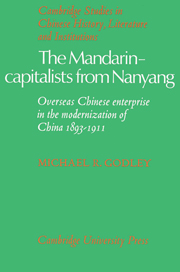 The Mandarin-Capitalists from Nanyang
The Mandarin-Capitalists from Nanyang Book contents
- Frontmatter
- Contents
- Dedicated to Marilyn, Heather and David
- Preface
- Note
- Map
- Introduction
- PART I THE RISE OF THE OVERSEAS CHINESE CAPITALIST
- PART II OVERSEAS CHINESE ENTERPRISE IN THE MODERNIZATION OF CHINA
- 5 A program for the development of industry and commerce
- 6 The search for overseas Chinese talent and wealth
- 7 South China's railroad offensive 1904–8
- 8 The overseas Chinese and economic change
- Epilogue: Old faces in a new government
- Notes
- Select Bibliography
- Glossary
- Index
7 - South China's railroad offensive 1904–8
Published online by Cambridge University Press: 23 September 2009
- Frontmatter
- Contents
- Dedicated to Marilyn, Heather and David
- Preface
- Note
- Map
- Introduction
- PART I THE RISE OF THE OVERSEAS CHINESE CAPITALIST
- PART II OVERSEAS CHINESE ENTERPRISE IN THE MODERNIZATION OF CHINA
- 5 A program for the development of industry and commerce
- 6 The search for overseas Chinese talent and wealth
- 7 South China's railroad offensive 1904–8
- 8 The overseas Chinese and economic change
- Epilogue: Old faces in a new government
- Notes
- Select Bibliography
- Glossary
- Index
Summary
In 1878, having observed the wealth and power of the West first hand, Hsueh Fu-ch'eng observed: ‘I think if the system of railway trains is not used, China can never be rich and strong.’ China's early attempts at railroad building were rather discouraging. When Sheng Hsuan-huai took over the management of the proposed Peking–Hankow line in 1896, however, hopes were raised that China might use railroads to help counter foreign aggression. The ways in which Sheng attempted to rally merchant support, organized modern banking and turned to Chang Pi-shih have already been outlined. Chang clearly shared Sheng's overly optimistic belief that China was ready to finance her own railroads. He undoubtedly shared Sheng's disappointment when self-reliance failed and Peking was forced to rely on a syndicate from Belgium for the construction of the Peking–Hankow route and to call in American capital for the Canton–Hankow line he supervised.
The ensuing half a dozen years were characterized by a battle among the Western powers for the right to finance, construct, and, in most cases, control new Chinese railroads. In his 1903 memorial, Chang Pi-shih acknowledged that China was probably not yet ready on her own to embark on trunk lines that stretched hundreds of miles. He therefore suggested that Chinese merchants could be recruited to begin work on short feeder lines through their own districts.
- Type
- Chapter
- Information
- The Mandarin-Capitalists from NanyangOverseas Chinese Enterprise in the Modernisation of China 1893–1911, pp. 149 - 172Publisher: Cambridge University PressPrint publication year: 1981
- 1
- Cited by


